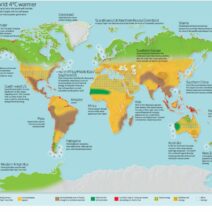As the ramifications of climate change continue to escalate, the quest for viable solutions has prompted significant inquiry into the role of science in addressing this formidable crisis. The traditional narrative surrounding climate change often emphasizes the need for behavioral change, policy reform, and grassroots activism. However, a burgeoning field of scientific inquiry is beginning to illuminate potential pathways that extend beyond conventional wisdom. Researchers are increasingly exploring innovative methods, ranging from geoengineering to carbon capture and storage, reshaping the dialogue about climate mitigation and adaptation strategies.
At the heart of this exploration is a fundamental question: can science genuinely resolve the climate crisis? Many environmental scientists, engineers, and researchers are optimistic that technological advancements can be harnessed to arrest the catastrophic effects of climate change, but the solutions require more than mere theoretical exploration. They necessitate rigorous experimentation, ethical considerations, and a steadfast commitment to sustainability.
One of the most provocative approaches under investigation is geoengineering, which encompasses large-scale interventions intended to manipulate Earth’s climate systems. Two primary categories of geoengineering have emerged within scholarly discussions: solar radiation management and carbon dioxide removal. Solar radiation management (SRM) includes techniques that aim to reflect a fraction of solar energy back into space, potentially mitigating global warming. For instance, stratospheric aerosol injection involves dispersing reflective particles into the atmosphere to cool the planet. This approach is as contentious as it is alluring; critics argue that it risks unintended consequences, including disruptions to local weather patterns.
On the other hand, carbon dioxide removal (CDR) focuses on reducing atmospheric CO2 levels through innovative technologies. One popular methodology is direct air capture, which utilizes large machines to extract CO2 from the atmosphere. This captured carbon can either be stored underground or repurposed in various industrial applications. Another intriguing avenue lies in enhanced weathering, which involves the deliberate application of certain minerals to accelerate natural processes that sequester carbon. While these strategies hold promise, they raise pressing questions about scalability, economic feasibility, and long-term dependency on unproven technologies.
Research has shown that nature itself offers a wealth of solutions, a perspective embodied in the concept of nature-based solutions (NbS). These strategies employ ecological processes to address climate change and bolster resilience. Reforestation, for example, has gained traction not merely as a carbon offset strategy but as a means of restoring biodiversity and enhancing ecosystem services. Wetland restoration, too, plays a critical role in carbon sequestration while providing vital habitats for countless species. The synergy between scientific understanding and the inherent resilience of natural systems underlines a profound shift in how we can approach climate action—one that marries human ingenuity with ecological wisdom.
Moreover, researchers are actively investigating the use of biotechnology to develop crops that can withstand climatic unpredictability. Genetic engineering and selective breeding may yield varieties that flourish in adverse conditions, thus ensuring food security amid shifting climates. These advances can significantly reduce agricultural emissions while simultaneously enhancing the carbon storage capacity of soils. However, such biotechnological interventions are not without controversy, particularly regarding ethical considerations and the long-term impacts on ecological systems.
The implications of these scientific endeavors extend beyond sheer technological advancement. They invite a reevaluation of economic structures, prompting discussions about how investments in green technologies can revolutionize industries and foster sustainable development. The transition towards a circular economy exemplifies this shift, where resources are utilized more efficiently, waste is minimized, and the need for raw material extraction is mitigated. The scientific community is investigating the potential of numerous sustainable business models driven by technology and innovation, further underpinning the argument that science can work in tandem with economic imperatives to combat climate change.
Public engagement and policy frameworks are paramount in actualizing scientific innovations. Without robust governmental support and public buy-in, even the most sophisticated technologies may falter. Collaborative efforts among scientists, policymakers, and civil society are essential to bridge the gap between scientific potential and real-world implementation. Strategies such as public education about the science behind climate solutions can generate grassroots support for environmentally conscious policies. A well-informed populace is more likely to advocate for policies that allocate resources toward scientific research and development.
Nevertheless, it is crucial to approach these scientific endeavors with prudence and ethical foresight. The risks associated with geoengineering and biotechnology necessitate comprehensive regulatory frameworks that ensure safety and efficacy. Additionally, the potential for socio-economic disparities exacerbated by the uneven distribution of technological solutions raises ethical dilemmas that must be confronted. Questions about who gets to wield these technologies and how they impact marginalized communities must be addressed transparently and inclusively.
The dialogue surrounding science and climate change is evolving, inviting diverse perspectives and interdisciplinary collaboration. This multifaceted endeavor demands not only scientific rigor but also philosophical reflection. As researchers delve into the scientific intricacies of climate solutions, they must remain cognizant of the broader implications for humanity and the planet. The urgency of climate action should motivate a synergy between innovation and ethics, ensuring that scientific advancements serve the common good.
In conclusion, the promise of science in combating climate change is considerable yet precarious. The interplay between advanced technologies and natural processes offers a wealth of potential solutions to one of the most daunting challenges of our time. As the world grapples with the implications of climate change, embracing a scientific outlook—one that values curiosity, ethical responsibility, and collaborative action—may pave the way for a more sustainable future. Ultimately, harnessing the power of science requires a collective commitment to transformative action, steering humanity towards a resilient and thriving existence on our planet.


